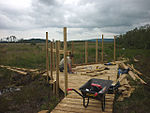The River Kent is a short river in the county of Cumbria in England. It originates in hills surrounding Kentmere, and flows for around 20 miles (32 km) into the north of Morecambe Bay. The upper reaches and the western bank of the estuary are located within the boundaries of the Lake District National Park. The river flows in a generally north to south direction, passing through Kentmere, Staveley, Burneside, Kendal and Sedgwick. Near Sedgwick, the river passes through a rock gorge which produces a number of low waterfalls. This section is popular with kayakers as it offers high quality whitewater for several days after rain. The village of Arnside is situated on the east bank of the Kent estuary, just above Morecambe Bay, and a tidal bore known as the Arnside Bore forms in the estuary at this point on high spring tides.
The river has been used as a source of power since at least the 13th century. In 1848, the construction of Kentmere Reservoir was completed, which was designed to ensure that millers had a more regular supply of water to enable their mills to operate throughout the year. There were corn mills and bobbin mills on the upper river, and the weir from the Staveley mill now supplies water to a turbine which generates electricity for the nearby industrial estate. Below Staveley there were three mills connected with the paper industry, the lower one of which is now the site of the paper manufacturer James Cropper PLC, although the current mill no longer uses water power. Within Kendal, there were mills serving the woollen industry, while the mill at Helsington was the last water-powered snuff mill in the country until its closure in 1991. Below Kendal, there were three mills making gunpowder, and the extensive ruins of New Sedgwick gunpowder mill still lie within the confines of Low Wood caravan park, which is owned by the National Trust.
The river flows through the town of Kendal, which consequently suffers from flooding from time to time. One of the most serious floods was in 1898, but there was also extensive flooding in 1954 and 1968. In the aftermath of the 1968 event, a flood defence scheme was designed by the Lancashire River Authority, and implemented in six stages between 1972 and 1978. A major component of the scheme was the widening and deepening of the river between Nether Bridge and Miller Bridge, requiring the removal of 310 thousand cubic yards (240,000 m3) of spoil, which was reused as the base for a business park. A large lagoon was also constructed to the north of the town to act as a gravel trap. Despite the work, Kendal was again inundated in 2015, when flows in the river far exceeded the design flow of the channel. The Environment Agency published plans for a new set of defences to protect the town in 2018.
The river is a Special Area of Conservation, particularly because it supports populations of the endangered white-clawed crayfish. It also supports populations of three types of game fish, and the upper reaches have become important for the rearing of juvenile salmon since fish passes were constructed to allow fish to negotiate the weirs on the river in 1986.










